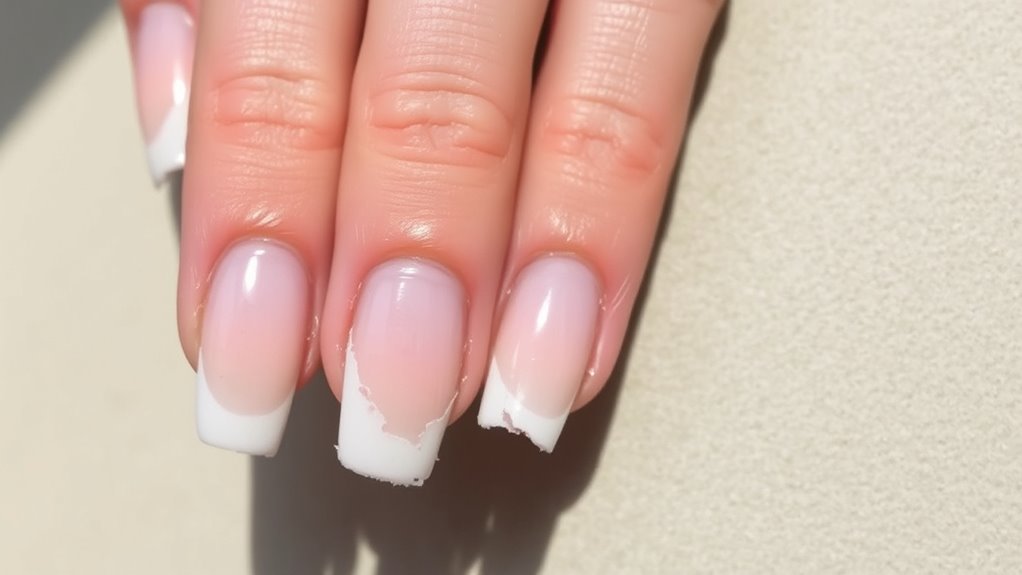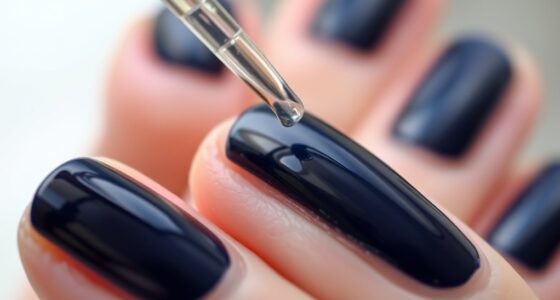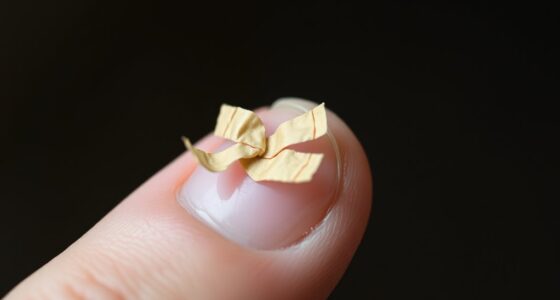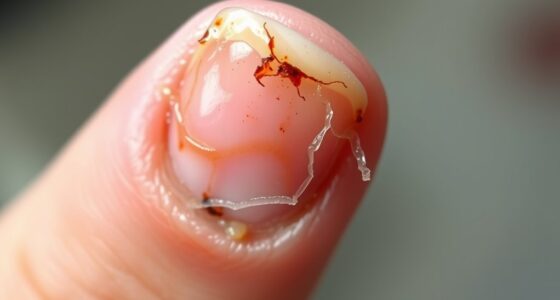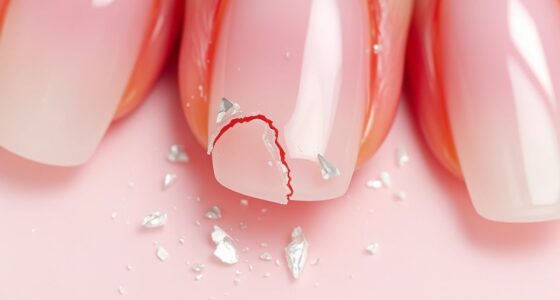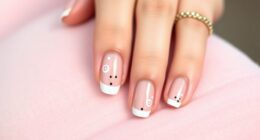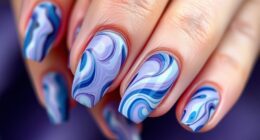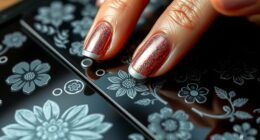If your gel manicure is peeling, start by identifying if improper application or environmental factors caused it. Gently remove peeling gel without force, and take care of your nails by moisturizing cuticles and avoiding harsh chemicals. Properly prepare your nails before reapplying gel—clean, buff lightly, and use a high-quality primer for better adhesion. For lasting results and helpful tips, discover the best ways to prevent and fix peeling gel manicures.
Key Takeaways
- Avoid forceful peeling; gently file or soak nails to remove peeling gel safely.
- Maintain nail hydration with cuticle oils and nourishing treatments to strengthen nails.
- Protect nails during chores with gloves and avoid harsh chemicals or excessive water exposure.
- Ensure proper nail prep, including cleaning, buffing, and using primer for better gel adhesion.
- Seek professional help if peeling persists or nails become brittle or painful.
Common Causes of Gel Peeling
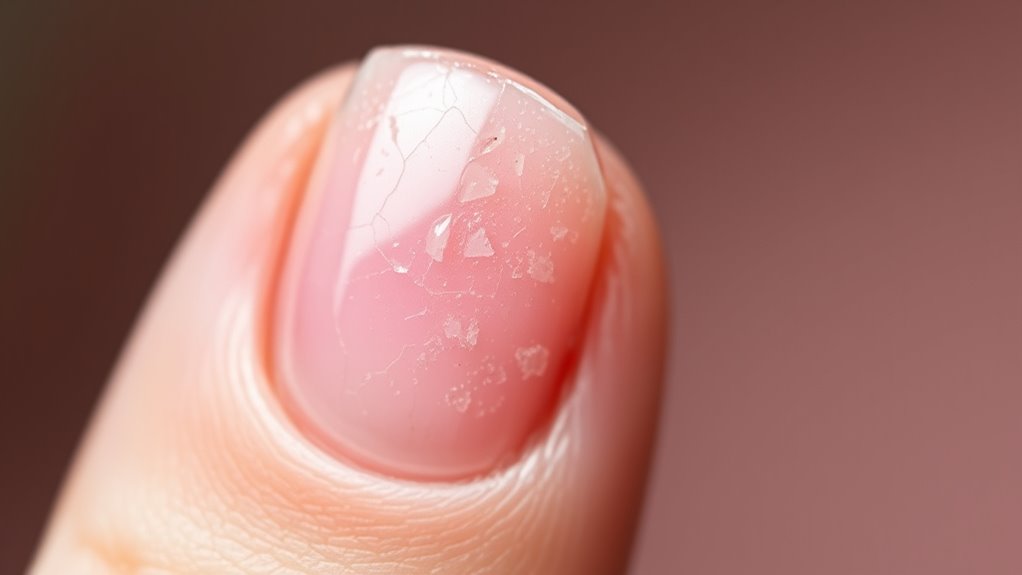
Peeling gel manicures often happen because of issues with preparation or application. One common cause is insufficient nail hydration; when your nails are dry or brittle, the gel doesn’t adhere properly, leading to peeling. Environmental factors also play a role—exposure to water, humidity, or harsh chemicals can weaken the gel’s bond to your nails. If you don’t prep your nails well or skip base coats, the gel may lift prematurely. Additionally, frequent exposure to water or cleaning products can compromise the manicure’s durability. Ensuring your nails are properly hydrated before applying gel and protecting them from environmental stressors can considerably reduce peeling. Proper preparation and awareness of environmental influences are key to longer-lasting gel manicures.
How to Prevent Gel Peeling

To keep your gel manicure intact for as long as possible, focus on proper application techniques and nail care habits. Prioritize cuticle health by gently pushing back cuticles and avoiding cuticle damage, which can lead to lifting and peeling. Maintain nail hydration by applying cuticle oil daily to keep nails flexible and less prone to cracking. Make certain your nails are clean and dry before applying gel, as moisture can cause adhesion issues. Avoid harsh chemicals and excessive water exposure, which weaken the gel bond. Wearing gloves during cleaning or chores also helps protect your nails. Additionally, using quality tools and products can improve the longevity of your gel manicure. Proper nail preparation and adhesion techniques are essential for preventing gel peeling. Ensuring your nails are properly clipped and filed can also help create a smooth surface for better gel adhesion. By caring for your cuticles and keeping your nails hydrated, you reduce the risk of peeling and extend the life of your gel manicure. Incorporating nail strengthening treatments can further support nail health and prevent peeling over time.
Proper Nail Preparation Before Application
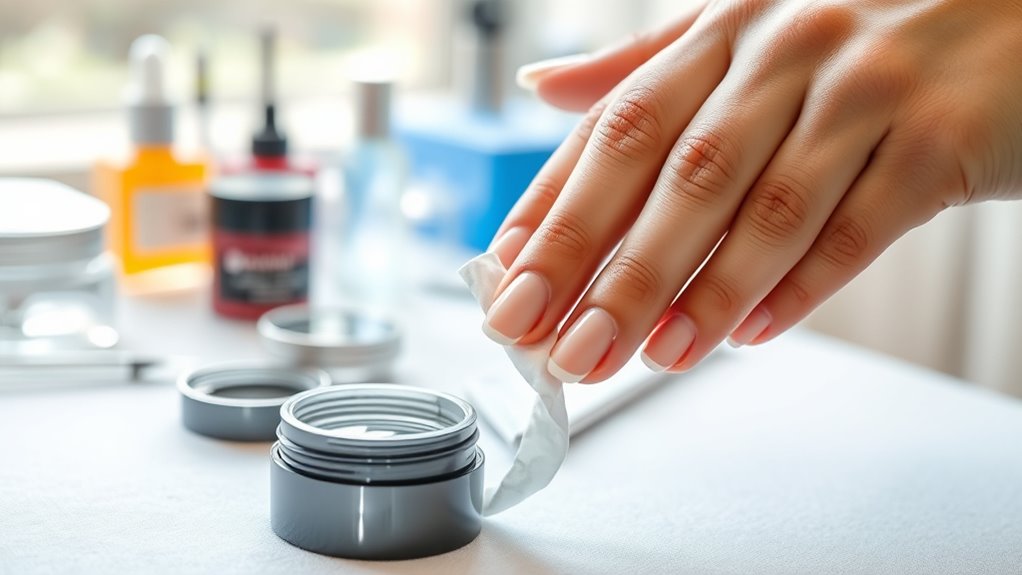
Proper nail preparation is essential for a long-lasting gel manicure. Start by cleaning your nails thoroughly to remove oils and dirt. Gently push back your cuticles and use a cuticle conditioner to soften them, making removal easier and preventing lifting. Next, lightly buff the nail surface to remove shine and create a rough texture for better adhesion. Apply a high-quality nail primer to eliminate residual oils and improve the bond between your natural nail and the gel. Be careful not to over-apply primer, as it can cause damage or lifting. Ensuring your nails are clean, dry, and properly conditioned sets a strong foundation, reducing the chances of peeling and ensuring your gel manicure lasts longer. Recognizing the significance of nail health and spiritual connection can also contribute to better overall manicure results. Additionally, maintaining overall nail health through proper diet and hydration can support stronger, more resilient nails for future manicures. Incorporating professional quality products into your routine can further enhance the longevity of your gel manicure. Utilizing advanced nail preparation techniques can also help achieve a more durable and flawless finish. Proper preparation is key to achieving a flawless, durable finish.
Tips for Maintaining Your Gel Manicure
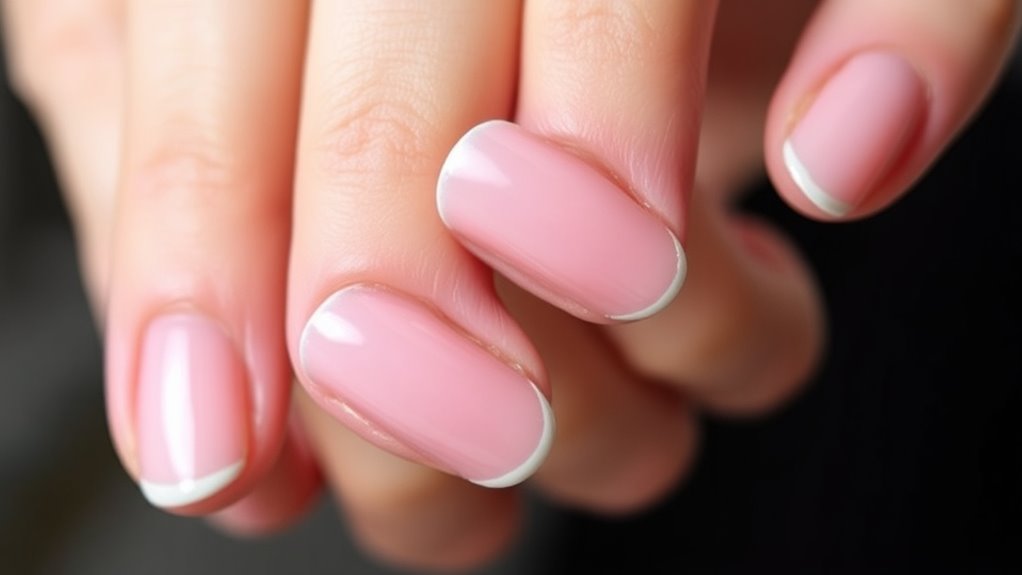
To keep your gel manicure looking fresh, maintaining proper nail care daily is crucial. Use gentle techniques when removing or touching up your nails to prevent damage. Small habits like moisturizing your cuticles and avoiding harsh tools can make a big difference in maintaining their appearance. Additionally, incorporating mindful practices such as sound vibrations can promote overall relaxation and reduce stress that may contribute to nail damage. Engaging in celebrity lifestyle habits like regular self-care routines can also support healthier nail growth and overall well-being. Remember that a relaxed mindset can improve your overall lifestyle, supporting healthier nail growth and appearance. Practicing stress reduction techniques can further enhance your nail health and prevent peeling or chipping.
Proper Nail Care
Maintaining your gel manicure starts with gentle care and mindful habits. To keep your nails looking fresh, avoid harsh scrubbing or using metal tools that can damage the gel. Protect your nail art by wearing gloves during household chores and moisturizing your cuticles regularly. Proper cuticle care prevents hangnails and promotes healthy nail growth, which helps your gel last longer. Keep your nails hydrated with cuticle oil and avoid biting or picking at your nails. When applying hand lotion, make sure to extend it to your cuticles to prevent dryness. Regularly check for chips or peeling and address them promptly to prevent further damage. Incorporating proper nail care can significantly improve its longevity and overall appearance. Consistent, gentle upkeep is essential for maintaining your gel manicure, and understanding skincare patches can also contribute to healthier nails. Additionally, using hydrating treatments can boost nail strength and resilience against peeling. Paying attention to your nail environment, such as avoiding excessive exposure to water and harsh chemicals, further supports nail health and longevity.
Gentle Removal Techniques
When it’s time to remove your gel manicure, doing so delicately helps preserve the health of your nails and prevents unnecessary damage. Start by soaking a cotton ball in acetone and placing it on your nail, then wrap it with foil for about 10-15 minutes. Avoid forcefully peeling or scraping, which can weaken nails and harm cuticle hydration. Instead, gently push off the softened gel with a cuticle pusher. After removal, focus on nail strengthening by applying nourishing cuticle oil and moisturizing your nails. Maintaining cuticle hydration is essential for healthy recovery, especially after gel removal. Incorporating proper nail care practices can further support healthy nail growth and prevent peeling. Taking these gentle steps ensures your nails stay strong, minimizes peeling, and helps you keep your manicure looking beautiful longer. Additionally, proper cleaning and maintenance of your nails and tools can prevent infections and promote healthier nail growth. Recognizing the importance of safe removal techniques aligns with practices that help prevent damage and maintain overall nail health. Being aware of nail health fundamentals can also guide you in maintaining resilient and attractive nails over time.
How to Safely Remove Peeling Gel
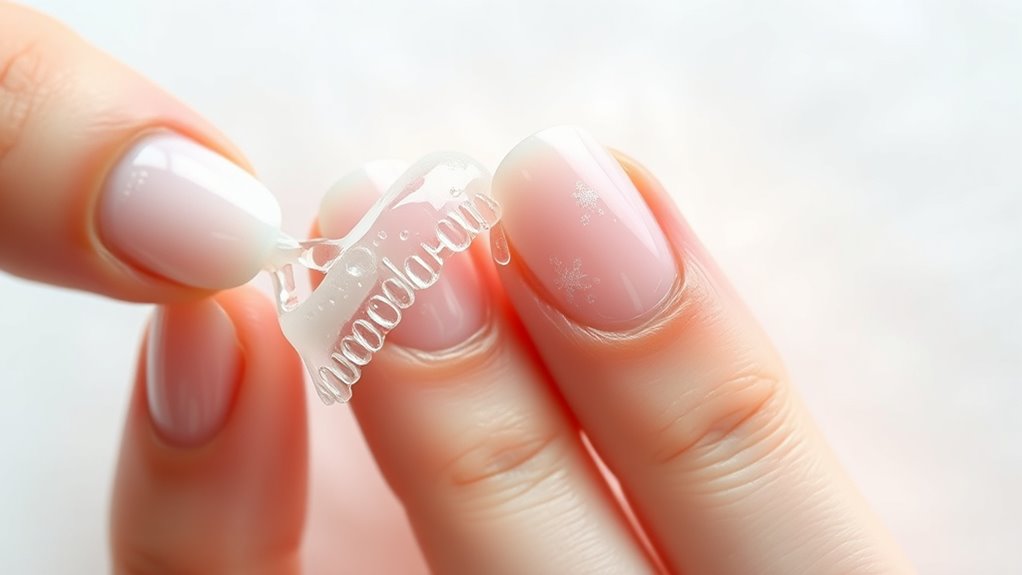
Removing peeling gel manicures safely is essential to protect your nails from damage. Start by softening the gel with acetone and gentle tools, avoiding force. Once the gel begins to lift, apply cuticle oil around your nails to nourish and hydrate the skin, helping prevent dryness and damage. Carefully lift the gel using a wooden stick or orange stick, working slowly to avoid peeling or damaging your natural nails. Be mindful of color fading; excessive scrubbing or peeling can cause pigment loss. If any stubborn areas remain, reapply acetone and wait a few more minutes before gently removing them. Patience is key—rushing can lead to nail damage. Proper technique minimizes the risk of nail damage and preserves the health of your nails. Finish by moisturizing your nails and cuticles to restore hydration and strength.
Repairing Damaged Gel Nails
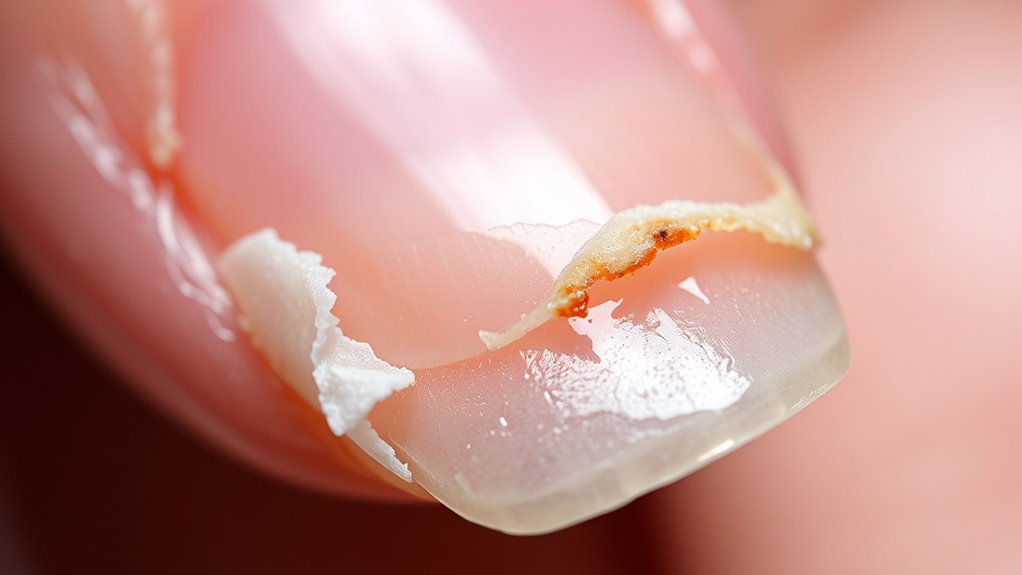
To repair damaged gel nails, start by using gentle removal techniques to avoid further harm. Follow up with nourishing treatments to strengthen your nails and promote healing. Remember, adopting preventative care tips can help keep your nails healthy and prevent future damage.
Gentle Removal Techniques
Gentle removal techniques are essential for repairing damaged gel nails without causing further harm. To begin, soak your nails in acetone to loosen the gel, then gently lift the edges with a wooden cuticle stick—never force them off. Applying cuticle oil around your nails provides a hydration boost, keeping your skin healthy during removal. Use soft, gliding motions to avoid damaging the natural nail plate. If any gel resists removal, re-soak and wait a few more minutes. Always prioritize patience over force, as aggressive removal can worsen damage. Finish by moisturizing your nails and cuticles with nourishing oil to restore hydration. These careful steps help protect your nails and promote healthy recovery after peeling gel manicures.
Nail Nourishing Treatments
After carefully lifting and removing peeling gel, your nails may appear weakened or damaged. To repair this, focus on nourishing treatments that restore strength and flexibility. Nail hydration is essential; use nourishing cuticle oils and hydrating nail serums daily to boost moisture levels. Proper hydration helps prevent brittleness and promotes healthier nail growth. Additionally, supporting cuticle health is crucial, so gently push back cuticles and apply nourishing oils to keep them soft and healthy. Consider using strengthening base coats or nail repair treatments specifically designed for damaged nails. Avoid harsh chemicals and excessive filing, which can worsen damage. Consistent nourishment and hydration will help your nails recover and regain their natural strength, making them more resilient to future damage.
Preventative Care Tips
Preventing further damage to your gel nails requires consistent preventative care. To protect your nails, focus on maintaining nail hydration by using moisturizing cuticle oils daily. Well-hydrated nails are less prone to peeling and breakage. Additionally, prioritize cuticle health by gently pushing back cuticles and avoiding harsh removing techniques that can weaken your nails. Regularly applying cuticle oil helps strengthen the nail bed and prevents dryness that can lead to peeling. Always wear gloves when doing chores or cleaning to shield your nails from chemicals and water exposure. Properly hydrating your nails and caring for your cuticles not only prevents damage but also promotes healthier, stronger gel nails. Consistent, gentle care keeps your nails resilient and reduces the risk of peeling.
When to Seek Professional Help

Knowing when to seek professional help is essential to avoid further damage to your nails. If you notice persistent redness, swelling, pus, or severe pain, these are signs of infection that require immediate attention. A professional can perform a proper nail health assessment to determine the extent of damage and suggest appropriate treatments. Don’t ignore symptoms like increased peeling, brittle nails, or persistent discomfort, as these can worsen without expert care.
| Issue | Symptoms | Urgency |
|---|---|---|
| Signs of infection | Redness, swelling, pus | Seek help immediately |
| Severe peeling or damage | Nails breaking or lifting | Schedule a professional visit |
| Persistent discomfort | Ongoing pain or sensitivity | Consult a nail specialist |
Frequently Asked Questions
Can Peeling Gel Manicure Damage My Natural Nails?
Peeling gel manicures can potentially damage your natural nails if not done correctly or if applied too frequently. Peeling causes may include improper removal or overuse of the gel, which can weaken nail health. You might notice thinning or brittleness over time. To protect your nails, make certain your technician uses gentle removal methods and gives your nails time to recover between manicures. Proper care minimizes damage and maintains healthy nails.
How Long Should a Gel Manicure Ideally Last Before Peeling?
Think of your gel manicure as a delicate garden fence that keeps beauty in. Ideally, it should last about two to three weeks before peeling begins, like weathered paint needing a touch-up. To maximize nail longevity, practice good gel maintenance, avoid harsh chemicals, and wear gloves during chores. With proper care, your manicure stays vibrant, and you enjoy its beauty longer, just like a well-maintained garden fence.
Are There Specific Brands of Gel Polish Less Prone to Peeling?
You wonder if certain gel polish brands are less prone to peeling. Brand recommendations like CND Shellac, Gelish, and Essie Gel Couture offer peel resistant formulas, making your manicure last longer. These brands use high-quality ingredients and advanced formulas that adhere well and resist chipping. Choosing these options can help you enjoy a durable, beautiful gel manicure without frequent peeling, saving time and frustration.
What Home Remedies Can Help With Peeling Gel Nails?
Like a gentle tide, home remedies can soothe your peeling gel nails. You should try massaging natural oils, such as coconut or olive oil, into your nails daily to nourish and strengthen them. Additionally, hydrating masks for your hands and nails can boost moisture and promote healthier growth. Consistent care with these simple, natural solutions helps your nails recover and reduces peeling, giving them a fresh, resilient look.
Is It Safe to Peel off Gel Polish Myself Regularly?
Peeling gel polish yourself may seem tempting for DIY removal, but it’s not the safest choice for nail health. Regularly peeling off gel can damage your nails, weaken their structure, and cause pain or infections. Instead, opt for proper removal methods, like soaking in acetone or visiting a professional. Prioritizing nail health guarantees your nails stay strong and healthy over time, preventing unnecessary damage from DIY removal.
Conclusion
So, next time your gel manicure starts peeling, remember that a little care goes a long way. With the right prep, maintenance, and gentle removal, you can keep your nails looking flawless. Sometimes, it’s just a matter of catching the signs early—like noticing a small peel before it spreads. After all, your nails deserve the same love and attention you give your favorite outfit, turning everyday moments into a chance to shine.
